Join or Sign In
Sign in to customize your TV listings
By joining TV Guide, you agree to our Terms of Use and acknowledge the data practices in our Privacy Policy.
How Shonda Rhimes' Scandal Harnessed Twitter to Become a Massive Hit
#WhoShotFitz was a game changer for ABC
The streaming wars are in full swing now, with more streamers than ever competing for their own slice of the entertainment audience. But back in the early 2010s, when Netflix, Amazon Prime Video, and Hulu were relatively new on the scene, live TV was still king. In his new book Social TV: Multi-Screen Content and Ephemeral Culture, Cory Barker breaks down how the TV industry tried to combat the imminent threat of on-demand video by turning to another digital frontier: social media.
Barker, a TV Guide contributor and assistant professor at Bradley University, reveals how the industry tried to exploit social media during this tumultuous time, examining case studies including HBO's collaboration with Twitter, AMC's Story Sync, Amazon "fan-sourcing" feedback on its pilots, and more experiments in a movement that ultimately flopped.
But one of the more successful campaigns was Shonda Rhimes' and ABC's attempt to capture live viewers by engaging with Scandal fans on Twitter. In the first chapter of Social TV, Barker recounts the live-tweeted origins of Scandal and #TGIT. Read on for an exclusive excerpt:

Kerry Washington, Scandal
Giovanni Rufino, ABCA May 2012 Associated Press report on the rise of live-tweeting began with an anecdote about actors joining the conversation. The story used Kerry Washington, star of the just-premiered Scandal, as its chief example. Without the involvement of ABC, Washington decided to answer fan questions during Scandal's pilot episode while she watched with family. As she recalled later, "I hate watching myself. So while the show was on, I was buried in my laptop tweeting. It was fun." Washington enjoyed the experience so much that she tweeted during the West Coast airing as well. That evening, Washington's Twitter feed revealed the origins of what would become a social media and television phenomenon. Though Washington's publicity team had previously controlled her account to promote Scandal, the star supposedly took over once the episode began. She encouraged viewers to send questions to the #AskScandal hashtag and responded to countless inquiries about her feelings on the script, production anecdotes, and plot teasers.
Washington responded to many questions by directly replying to fans, preceding her answers with a friendly "hey" and finishing with playful emoticons, exclamation points, all-caps enthusiasm, and endearingly awkward formatting. In a foundational moment, she retweeted one user's idea for what to call fans: "'Here On Out, Us Fans Of The Show Will Be Known As #Gladiators? ;)' I LOVE THAT!"
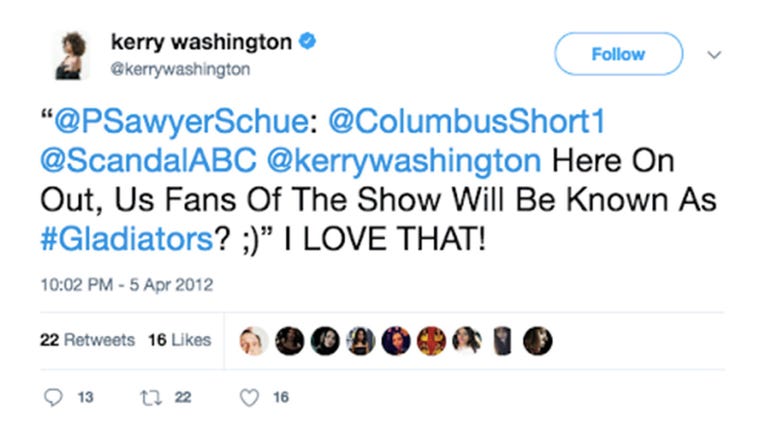
The use of "Gladiators" came from the pilot episode, in which the political fixers led by Washington's Olivia Pope are referred to as "gladiators in suits." When a fan proposed the nickname for the fans to Washington and co-star Columbus Short, she responded enthusiastically. Just thirty minutes later, the use of #Gladiators had already taken hold, as Washington and co-star Darby Stanchfield expressed their gratitude with the term of endearment.
***
Though most of the initial discourse about Scandal placed the series within the context of Shonda Rhimes's previous efforts and auteur persona, Washington's live-tweeting of the pilot gave the series a Social TV mark of distinction. But Washington also catalyzed a sense of community among the cast, crew, and fans that would be co-opted by ABC's promotional machinery.
Before Scandal, Rhimes promoted the live-tweeting of her series, but the practice usually only happened during significant events like crossovers and ratings sweeps periods. But as Rhimes credited in Variety, Washington's activity morphed live-tweeting into "a different tool" for producers and ABC.
***
While Scandal garnered modest Nielsen ratings in its first season, the coordinated #AskScandal campaign helped each episode produce thousands of tweets. But by the first season finale, ABC began to push more obvious promotional tactics into the Twitter community. Along with #AskScandal, the network promoted a new hashtag, #WhoIsQuinn, a reference to a finale plot twist involving the secret identity of Quinn Perkins (Katie Lowes). Washington, Lowes, and the official Scandal account circulated the hashtag immediately during the episode and throughout the summer and fall in preparation for season two: "LOVE reading all ur #WhoIsQuinn theories! Keep trying ;) U WILL find out 2night! Tell ur friends u won't want to miss it. #Scandal"
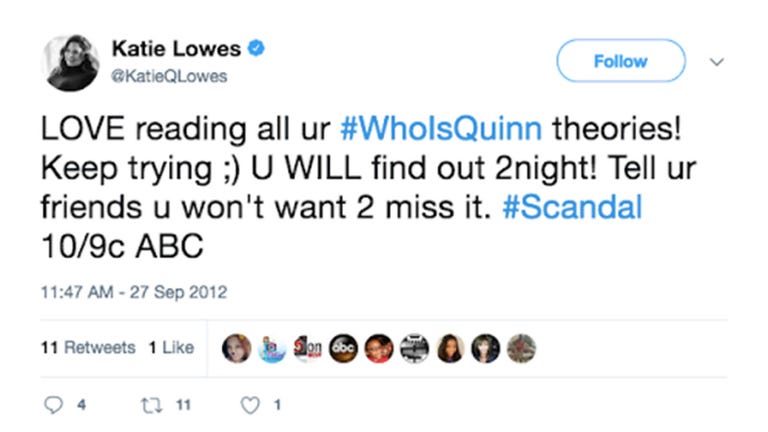
#WhoIsQuinn epitomized a shift for Scandal as a multi-screen social series. The new tagline tried to appropriate one of Rhimes's patented cliffhangers not just for a mystery that would keep the audience talking throughout the summer but also for a hashtag that would keep them talking on a specific platform like Twitter. Rather than focus on the spontaneous and enthusiastic chatter between stars and fans, the campaign aimed to channel fan energy toward a more coordinated conversation. The network's attempted co-opting of the enthusiasm surrounding Scandal produced a sharp contrast among the above #WhoIsQuinn tweets. The network account offered a generic question as a performance of engagement, whereas Washington and Lowe retained their passionate tone and style visible in other tweets. These vernacular distinctions expressed a tension in Scandal's move from an organic Social TV sensation to a more manufactured seeker of viral attention. Indeed, #WhoIsQuinn was more than a hashtag; ABC created an ARG-like website — whoisquinnperkins.com — featuring "depositions" of Quinn's co-workers and her mugshot seen on the series. The site was framed as a rogue exposé against Olivia's firm: "Olivia Pope has her hands full with a scandal of her own. It seems the renowned fixer has something to hide." Each video teased upcoming plot twists and reiterated the season two premiere date.
On the one hand, #WhoIsQuinn revealed how the combination of television storytelling, on-screen hashtags, and fervent tweeting could drive interest in a live episode and later sustain it into the next season's premiere. Rhimes trained viewers to expect major cliffhangers, motivating them to watch live and not be spoiled. Chatter between seasons only cultivated anticipation more, making the need to watch the premiere live even more pressing than before. Simulations of liveness and immediacy—of knowing the information and sharing the experience—were useful tools in the battle against time-shifting. On the other hand, the execution of #WhoIsQuinn embodied a familiar model of audience management and content distribution online. Those who followed #WhoIsQuinn to the website were granted access to small bits of new information but only in the form of brief teaser videos common to network publicity since the mid-2000s. Engagement with fellow fans was funneled through faux-interactive content. The corporate strategy did not effectively convince more people to watch live. The season two premiere of Scandal had lower ratings than most season one episodes.
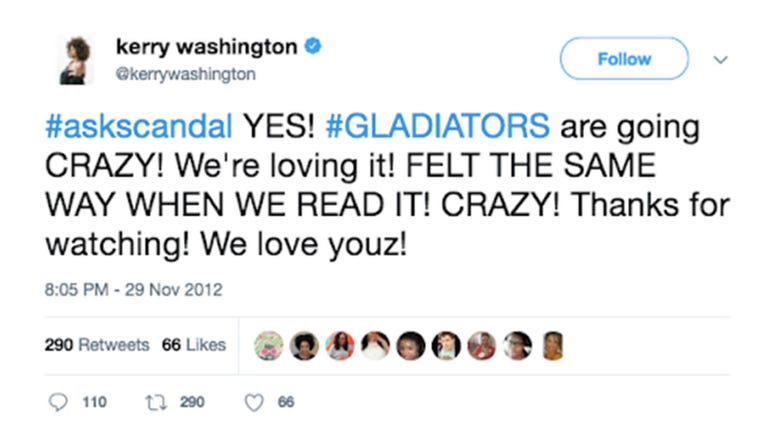
Despite this potential misstep, the social chatter around Scandal continued to grow in the fall of 2012. During a pivotal moment of the November 29 episode—the attempted assassination of Goldwyn's Fitz by an unknown culprit—ABC debuted another mystery-oriented social campaign. The response to the cliffhanger was predictably intense, as Washington nurtured the shock by retweeting nervous fans and performing her all-caps excitement: "#askscandal YES! #GLADIATORS are going CRAZY! We're loving it! FELT THE SAME WAY WHEN WE READ IT! CRAZY! Thanks for watching! We love youz!"
ABC, however, rapidly directed fans to a new hashtag, #WhoShotFitz, a reference to another famous network promotional campaign, "Who Shot J. R.?" from the CBS soap Dallas. Both Washington and the @ScandalABC account immediately started using the hashtag. The latter also circulated an image of Fitz in the design of Shepard Fairey's famous poster featuring Barack Obama with "#WhoShotFitz" awkwardly in the place of "HOPE." But the network seemingly learned its lesson from #WhoIsQuinn. Rather than try to push fans to separate websites or ancillary video content, #WhoShotFitz was entirely centered on social media chatter. The official press release declared that the campaign would help fans "explore the theories and questions behind the storyline" on Twitter as the cast live-tweeted December episodes.
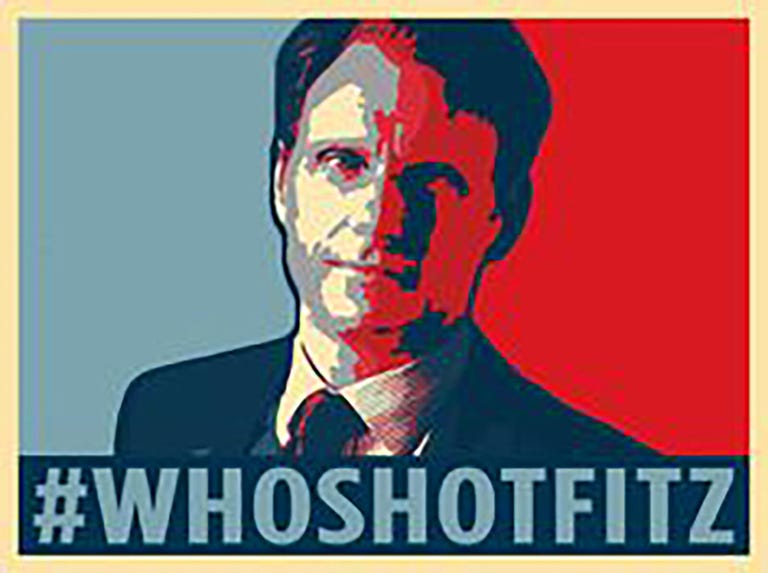
#WhoShotFitz demonstrated the new potential of a social media-driven multi-platform campaign. Conventional trailers for both online and broadcast audiences teased that "the gunman will be revealed." The hashtag appeared on-screen during subsequent episodes as the cast solicited fans' most complex theories during the live-tweeting conversation. And ABC continued to circulate illustrations of Fitz and the hashtag. This material worked in concert for maximum social shareability and to build anticipation for new evidence and new episodes. While the focus was on spontaneous social media chatter, ABC still used this material to guide audience attention from screen to screen and generate that chatter—both in the live broadcast environment and between each Scandal episode.
***
Hashtag initiatives like this one also construct an imaginary universal collective experience that promotes the false idea that everyone is watching and tweeting along in the same way at the same time—one approved multi-screen flow experience for all. In trying to structure the online conversation around specific pre-approved talking points, #WhoShotFitz capitalized on the genuine community emerging around live episodes of Scandal. While this strategy did not necessarily minimize the value of the shared collective experience of watching and live-tweeting, it exhibited how networks were beginning to understand how to incentivize people to participate in that experience in ways that most benefited corporate objectives.
Scandal scored record ratings in the 18–49 age demographic and total viewers for episodes promoted around the attempted assassination of Fitz. The December 13, 2012 installment, which revealed the shooter's identity, also drew 2,838 tweets per minute and nearly 158,000 across the hour. When Scandal returned from its holiday hiatus in early 2013, ABC more consistently promoted #AskScandal on its airwaves. Meanwhile, Scandal's live ratings and social footprint continued to grow, as did press coverage about the cast and fans "watching together." The Hollywood Reporter pointed to Twitter as key to Scandal's "sophomore growth spurt," with a recent episode producing five worldwide trending topics and the highest-ever retention of the Grey's audience. An Entertainment Weekly cover story stressed Scandal's appeal as a "live-tweet-every-oh my God moment viewing experience." Slate produced weekly "tweet-watch" posts, collating tweets from actors, fans, and critics. Twitter, always angling to collaborate, partnered with Stanchfield to collect "the best Scandal Tweets of the night" in one place, and cross-promoted the event on its official blog.

Tony Goldwyn, Scandal
Eric McCandless, ABCThe numbers reinforced the hype. Scandal spawned 2.85 million tweets in season two, 25 percent more than the popular and live American Idol. A mid-season episode generated nearly double the number of tweets as the anticipated premiere of Game of Thrones. Once Nielsen's Twitter TV ratings were operational, Scandal was cited as one of the "most social" series on television. During the 2013–14 season, it consistently inspired more than 400,000 tweets that were seen by 2.5 million unique users and produced over 25 million impressions. Scandal's live ratings also continued upward, despite declines elsewhere on broadcast television. Near the end of season three in April 2014, Scandal was both the fastest-growing and highest-rated broadcast drama among viewers aged 18–49.
The press linking Scandal's ratings growth to the social chatter acted as a critical legitimating tool for both the series and for Twitter-oriented promotion. That live-tweeting mattered at all, let alone could help improve live viewership or convince a broadcast network to alter its promotional practice, signaled new definitions for industry success. At the 2013 upfront presentation to advertisers, ABC president Paul Lee called Scandal "a game-changing hit," touting its extensive social profile and engaged fanbase. Lee's comments indicated that ABC believed that companies should place ads on Scandal not just because of its budding viewership but also because of its social footprint—and spend they did. Lee later praised Rhimes for bringing in nearly $300 million in advertising revenue, 5 percent of ABC's total figure. As Nielsen worked to find a correlation between tweets and live viewership (and thus tweets and ad dollars), executives had already begun to act as if the relationship was self-evident.
***
#WhoShotFitz, meanwhile, was cited as the inspiration for ABC's full-scale embrace of social media promotion. Goldwyn admitted that, while before #WhoShotFitz, the actors "were hype on a grassroots level," the cor-porate barrage for the hashtag helped live-tweeting catch on "like wildfire." In fact, Twitter had become so crucial to ABC that network officials asked Rhimes and Peter Nowalk, the creator of How to Get Away Murder, if they had considered the promotional challenges of translating the program's long title into an easily shareable hashtag. Meanwhile, Rhimes and Shondaland were credited with exposing the value of live-tweeting to the entire industry. According to Twitter executive Anjali Midha, Scandal and ABC were "driving the kind of behavior that advertisers and networks really care about." As Nielsen's Twitter TV Ratings and reports about the increases in multi-screen use circulated in the press, the influence of live-tweeting was no longer speculative or seen as a fun gimmick. Executives, actors, and corporate partners agreed about its value to the viewing experience—and the bottom line.
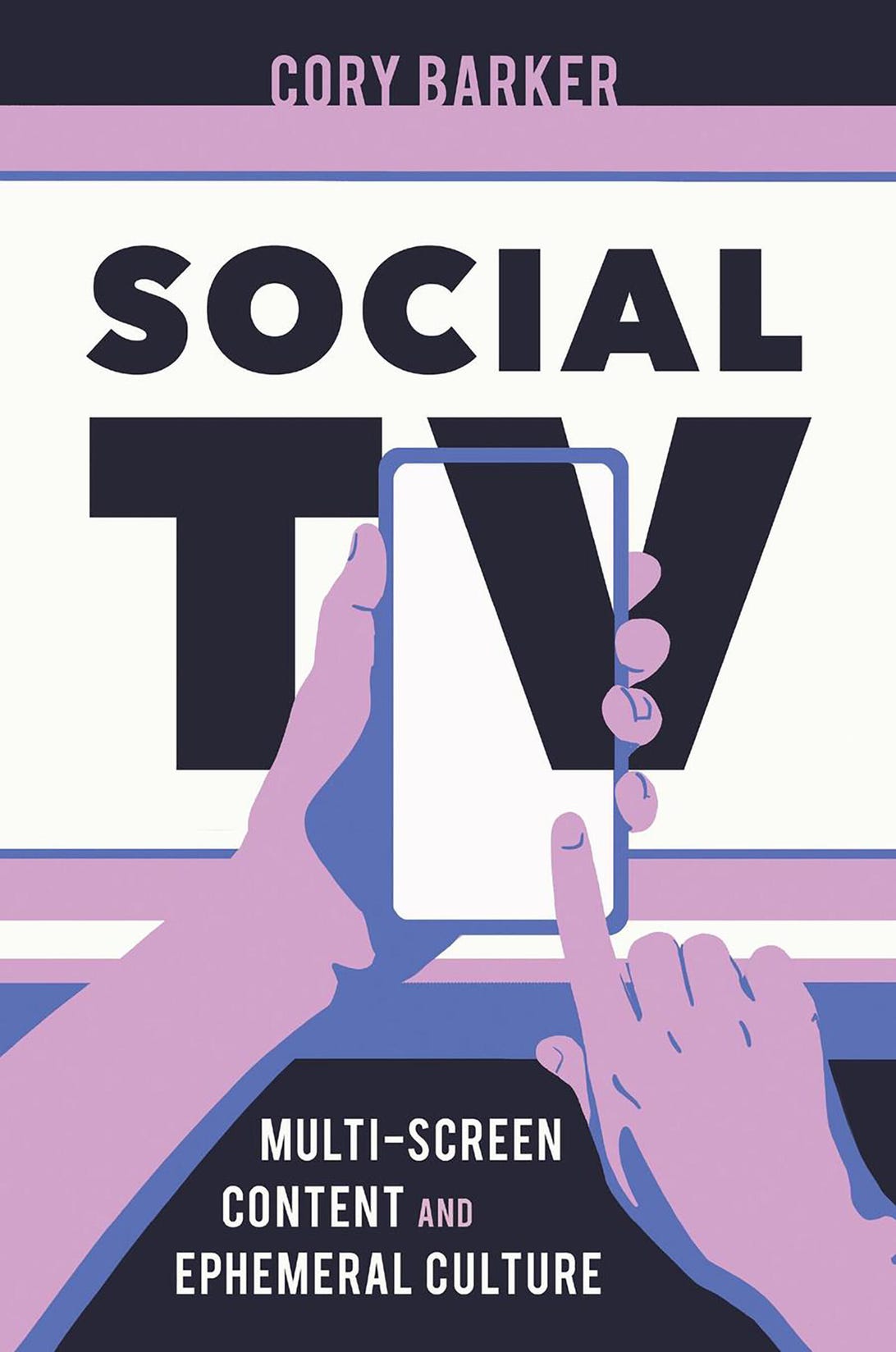
Social TV: Multi-Screen Content and Ephemeral Culture by Cory Barker
Cory Barker is an Assistant Professor in the Department of Communication at Bradley University. He has written about TV and social media for TV Guide, TV.com, Vox, Complex, and The A.V. Club. You can follow him on Twitter @corybarker.
To read the full story of Scandal and #TGIT, plus analysis of AMC's Story Sync, Amazon Studios's Pilot Season, long-dead check-in platforms GetGlue and Viggle, and more, order Social TV below.
